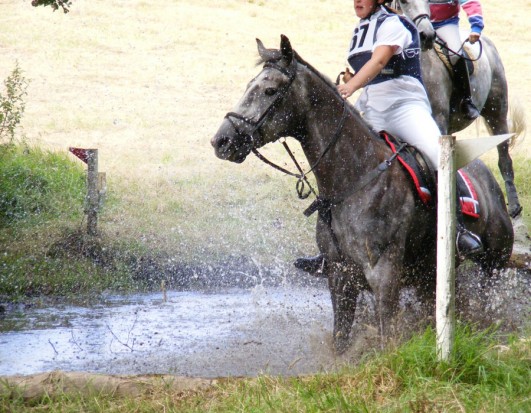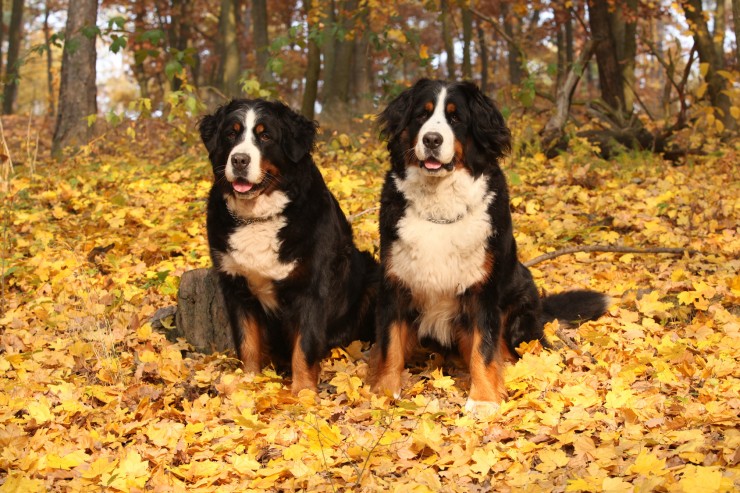

Cross country riding is an endurance test of horse and rider, performed over a large and wide ranging course involving various obstacles and fences completed while timed. Cross country is one of the three disciplines that together form the 'eventing' competitive sport, along with show jumping and dressage. Cross country riding is also often held as a standalone competition, when it is simply referred to as cross country, or hunter trials.
The object of cross country riding is to test the endurance, speed and jumping capability of horse and rider, as well as the rider's understanding of their mount and proficiency in working through challenges, and managing their horse's progress across an extended course as they become progressively more tired.
Riders of all ages and with mounts of all sizes can get involved in cross country, once they have reached a good level of general ridden competency and skill over fences. Both the cross country horse and rider must be very fit and maintain peak condition, in order to have the energy and acquired endurance reserves necessary to complete a long course safely and efficiently.
There is no such thing as a 'typical' cross country course, and no two courses are ever the same. As well as complicated extended courses for experienced eventers, some cross country courses are designed for younger riders and those new to the sport, with lower fences and a fairly intuitive design in order to enable safe completion and a positive, enjoyable ride while still stretching the skill set of both horse and rider and enabling onwards progression. Cross country courses may be either permanent, with fixed obstacles which are utilised regularly and used as a regular spot for training or competition, or constructed specifically for a short period of time or for a given event. It's not uncommon for a cross country course to actually comprise of two or more set routes within its layout, to reflect different levels of ability and standards of competition for different riders. Often, the fences and obstacles in cross country courses will consist of two different heights or styles of fences alongside of each other on the same route, one for novice competition or younger riders, and one for more proficient cross country competitors riding to a higher standard.
Generally, the overall ridden distance of a cross country course is between 2.5 and 4 miles long, and includes around 24 to 36 fences or obstacles. The fences and obstacles are designed to look rustic and natural and fit in with their surroundings, emulating the kind of naturally occurring obstacles a rider would encounter on the hunting field or in the country, including logs, streams, banks and ditches.
The route through a cross country course is denoted by flags, with a white flag to the left and a red flag to the right of all of the component obstacles, and each obstacle individually numbered. Even with these guidelines in place, the length of a cross country course and the level of concentration involved when riding a course can be confusing, so it's important for a rider to walk the course before starting out, in order to get a feel for it and memorise the best route through and how they would like to take it.
In competitive cross country events, each rider is timed from start to finish, with a combination of the total time taken and any errors or faults incurred used to score the riders. The lowest scoring rider is the ultimate winner, with a combination of a fast time and low fault score.
Faults can be added to a rider's score by a variety of means, including disobedience faults incurred from the horse refusing an obstacle, or time faults from failing to complete the course within the organisers' set completion time. Faults raise the rider's score, and so reduce their chances of placing well. Falling from the horse, taking the wrong route, jumping the same obstacle twice in error, missing an obstacle or jumping a fence in the wrong direction all result in elimination.
Because of the length of the course and the time taken to complete it, riders are often set off on the course in a staggered fashion, and two or more riders may be working through different parts of the course simultaneously. If at any point a rider ahead in the course runs into difficulties which may hold up a rider behind, the timer is stopped for the rider(s) already within the course behind them, and they are instructed to hold back until they can be safely be allowed to recommence. While the riders held up are not penalised in terms of their time due to an issue with another rider, stopping a competitor part way around the course can have a significant impact on their flow and rhythm, so this is avoided wherever possible. Failing to stop when indicated to on a course is cause for elimination, as is both deliberately obstructing the route of a rider attempting to overtake, and overtaking unsafely (such as by ruining another rider's approach to a fence).
There are lots of different ways for the competent novice rider to get involved in cross country events and have a go at a course. Riding clubs and pony clubs often have a cross country course, or construct one at certain times of the year for training days and events. Larger riding schools and equestrian centres may also have their own course as well. In some areas, it's possible to hire an established cross country course from a private owner, so if you have a group of friends and interested parties willing to pitch in, you may be able to get a course all to yourself for the day or even longer at a reasonable cost.
Understandably, cross country eventing can be dangerous if not adequately supervised and conducted carefully. Cross country courses should always be supervised and stewarded when in use, either for competition or training and schooling, and a competent first aider should always be on hand in case of any accidents.
Talk you your riding instructor about cross country riding, and get your skill level assessed before going forwards. Make sure that your instructor agrees that both you and your horse or pony are ready and able to try some cross country style fences safely, and be prepared to start small and work up. You should not expect to be able to ride a full cross country course as a newcomer to the discipline, and should work to build up your skill and ability over individual fences and smaller courses, as well as working on the general fitness level of both yourself and your horse before attempting a full length course or getting involved in competition.
 The Problem Of Undershot Jaws In The Pekingese
The Problem Of Un
The Problem Of Undershot Jaws In The Pekingese
The Problem Of Un
 Ten Picnic And Barbecue Foods Your Dog Should Not Eat
Ten Picnic And Ba
Ten Picnic And Barbecue Foods Your Dog Should Not Eat
Ten Picnic And Ba
 Dogs Copy Other Dog’s Behaviour - Good And Bad!
Dogs Copy Other D
Dogs Copy Other Dog’s Behaviour - Good And Bad!
Dogs Copy Other D
 5 Dog Breeds With A Sense Of Humour
5 Dog Breeds With
5 Dog Breeds With A Sense Of Humour
5 Dog Breeds With
 Research Shows 3 New Viruses Could Be Linked To Feline Cancer
Research Shows 3
Research Shows 3 New Viruses Could Be Linked To Feline Cancer
Research Shows 3
Copyright © 2005-2016 Pet Information All Rights Reserved
Contact us: www162date@outlook.com